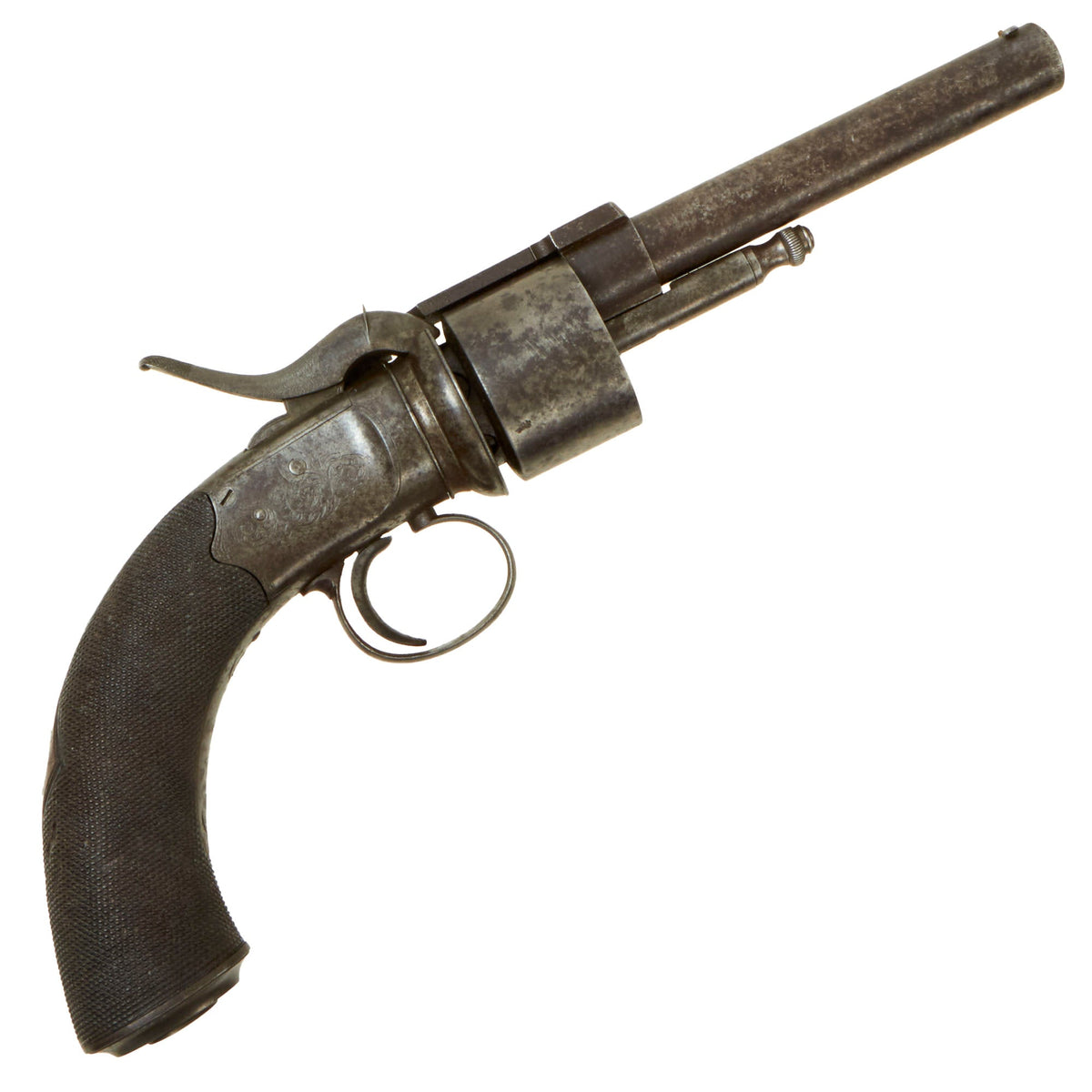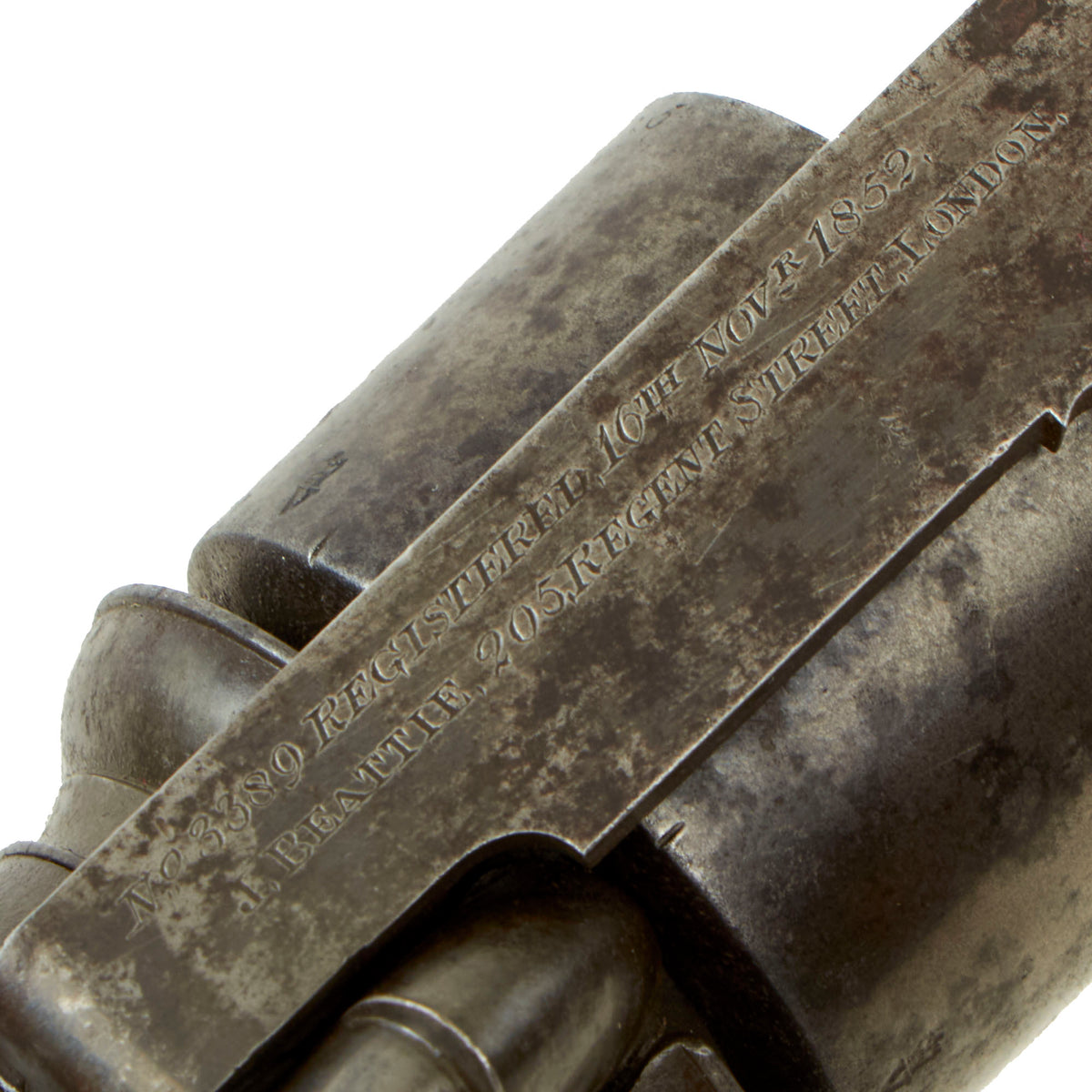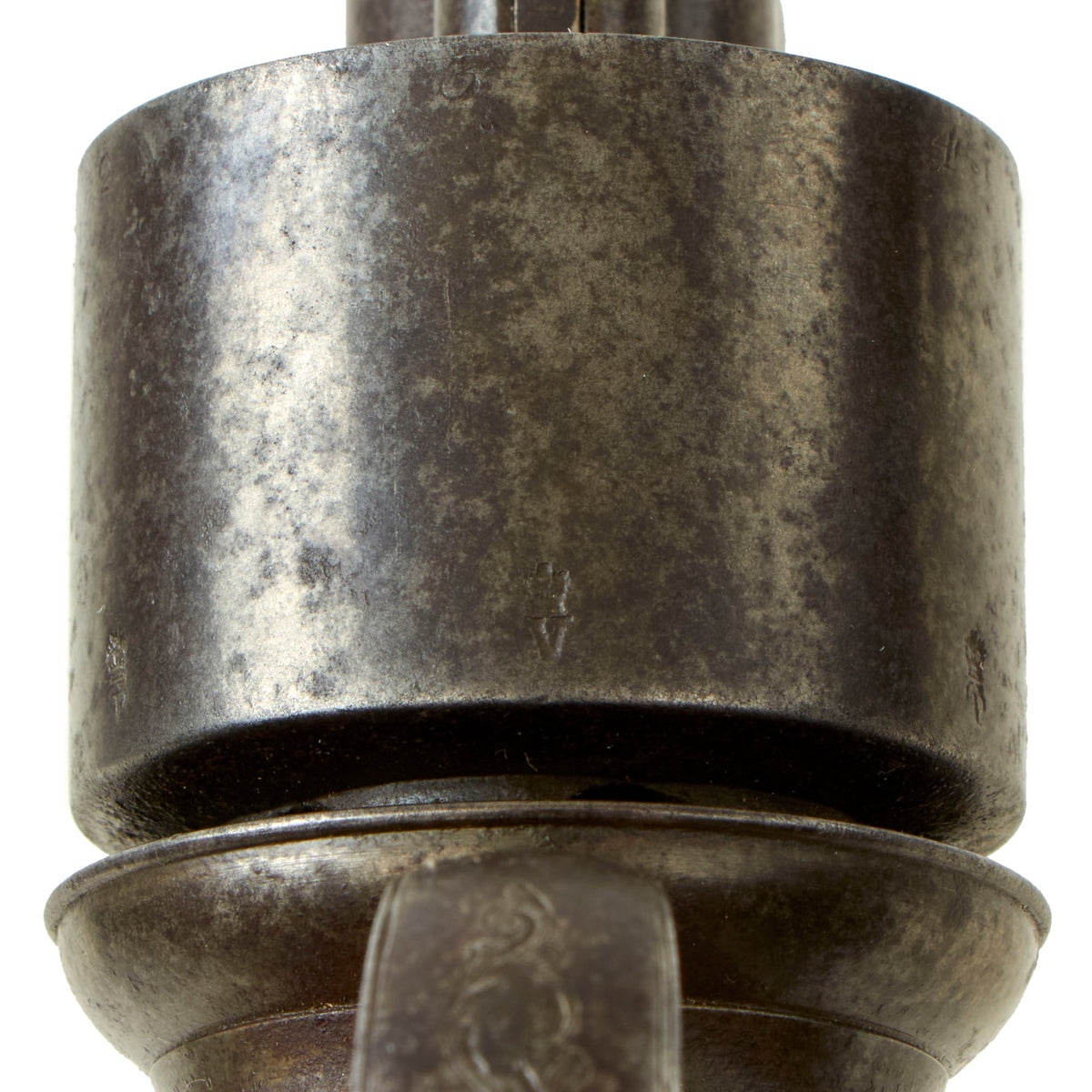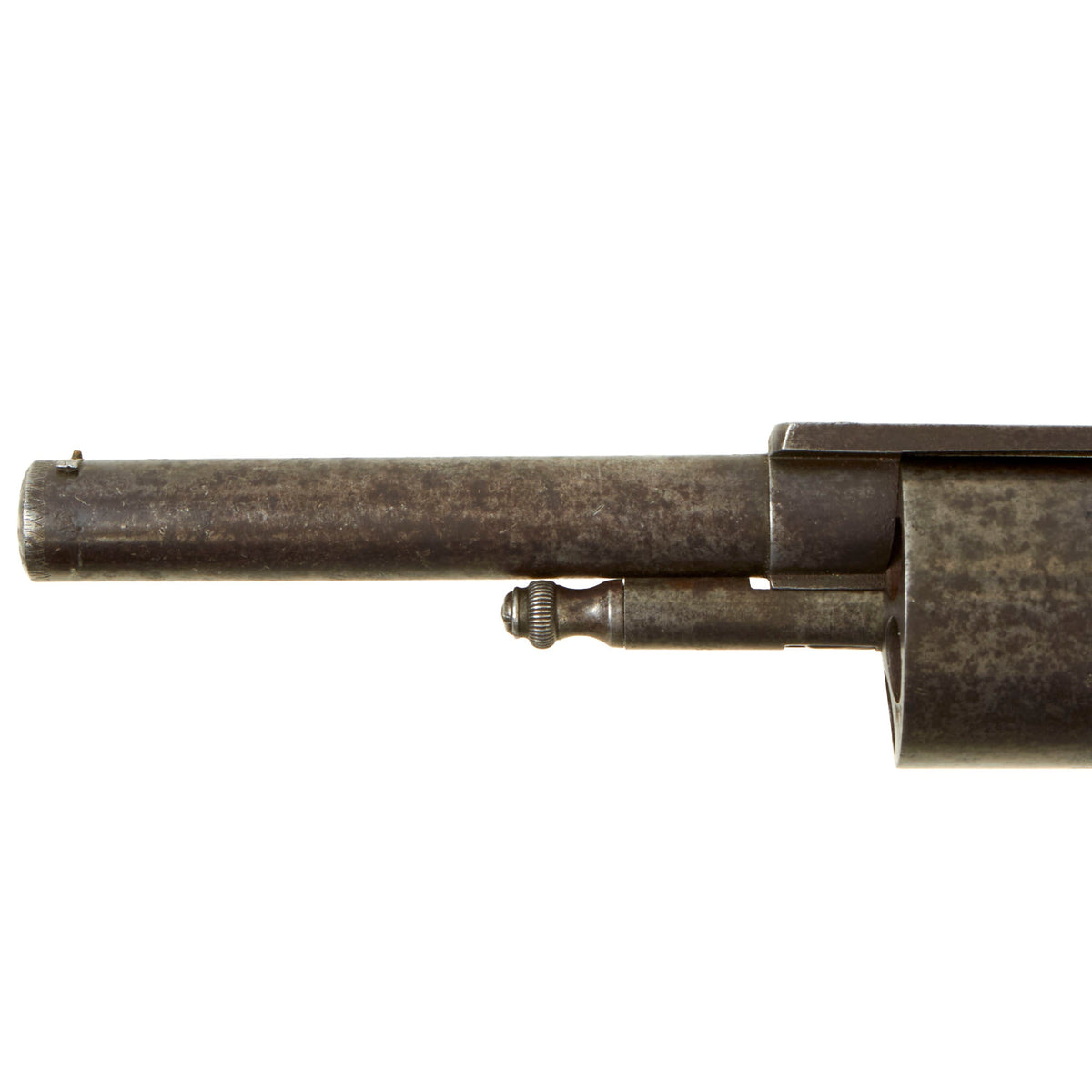Original British Victorian .44cal Single Action Transitional Percussion Revolver by James Beattie of London – circa 1850 Original Items
$ 2.395,00 $ 598,75
Original Item: Only One Available. This is a truly lovely example one of the many “Transitional” revolver designs of the first half of the 19th century, which effectively bridged the gap between single shot pistols and the modern revolver designs such as those made by Adams, Colt, and many others. These were main divided into two types: those that used a revolving cylinder / chamber with a single barrel, and the “Pepperbox” style, with a barrel cluster that revolved around a single arbor pin. Transitional revolvers utilized many features that were not carried on to the period of modern revolvers, which makes them a very interesting piece of firearms history.
Here we have a lovely British single action transitional revolver, which looks quite a bit like the revolvers made by Springfield Arms Co. in the United States, based on the patents of Joshua Stevens and James Warner. The overall design is similar, and it definitely shares some major features, such as the tip up barrel and hinged top strap. Other parts of the design, such as the ratchet action on the rear of the cylinder, are quite different. Instead of the hook used by the Springfield Arm design, the cylinder is held in place by a sprung arbor pin latch, which was a registered design (No. 3389) of Benjamin Cogswell. This is indicated on the top of the barrel strap, which is marked:
No. 3389 REGISTERED 16TH NOVEMBER 1852
J. BEATTIE. 205 REGENT STREET, LONDON.
James Beattie is a known gunmaker who worked in London during the 19th century, working from 1849 to about 1879. In 1865 he took his son into his business, when it became known as J. Beattie & Son. Transitional revolvers were really only made during the 1850s, as by 1860 the “modern” revolver concept was really starting to solidify.
Our example is a definitely lovely, and it features beautiful engraving on the hammer, on the frame, and on the trigger guard. There is also some on the end of the barrel, which has a bore of about 0.44″, showing a large number or rifling grooves. The revolver features a lovely curved checkered wooden grip, which is in excellent condition, bearing an oval silver escutcheon on the back, and an iron butt cap with a compartment for patches or bullets.
The cylinder is numbered 1 to 6 over the chambers near the front, while the rear is marked with alternating CROWN / GP “Gunmaker’s Proof” and CROWN / V “Viewed” markings from the London Gun Company proof house. There is another pair of these markings on the top of the barrel just forward of the top strap. The finish on the metalwork is very good, showing some of the original finish, while most if it now displays a gray lightly oxidized patina. The barrel shows some light peppering on the exterior, but nothing major.
We tested the action, and it functions beautifully, and does not appear to have any issues with indexing or cycling. The cylinder lock up is very secure, and the revolver easily breaks open for cleaning and reloading. The bore is in very good condition, showing a mostly bright finish with clear lands and grooves. There is not much wear, and just a bit of past fouling and oxidation in the grooves. All 6 cap nipple cones are intact, showing fouling and oxidation from use.
A lovely example of a rare stepping stone in revolver evolution, and definitely a gun for someone of some importance, as these were only really available to the well-heeled. Nicely engraved decoration, and a fantastic look. Ready to display!
Specifications:
Year of Manufacture: circa 1850
Caliber: approx .44″
Ammunition Type: Cap and Ball
Barrel Length: 4 3/4 inches
Overall Length: 11 7/8 inches
Action: Single
Feed System: 6 Shot Revolver
NOTE: International orders of antique firearms MUST be shipped using UPS WW Services (courier). USPS Priority Mail international will not accept these. International customers should always consult their country’s antique gun laws prior to ordering.
Fast Shipping with Professional Packaging
Thanks to our longstanding association with UPS FedEx DHL, and other major international carriers, we are able to provide a range of shipping options. Our warehouse staff is expertly trained and will wrap your products according to our exact and precise specifications. Prior to shipping, your goods will be thoroughly examined and securely secured. We ship to thousands clients each day across multiple countries. This shows how we're dedicated to be the largest retailer on the internet. Warehouses and distribution centres can be located throughout Europe as well as the USA.
Note: Orders with more than one item will be assigned a processing date depending on the item.
Before shipping before shipping, we'll conduct a thorough inspection of the items you have ordered. Today, the majority of orders will be delivered within 48 hours. The delivery time will be between 3-7 days.
Returns
The stock is dynamic and we cannot completely manage it because multiple stakeholders are involved, including our factory and warehouse. So the actual stock may alter at any time. It's possible that you may not receive your order once the order has been made.
Our policy is valid for a period of 30 days. If you don't receive the product within 30 days, we are not able to issue a refund or an exchange.
You can only return an item if it is unused and in the same state as the day you received it. You must have the item in its original packaging.
Related products
Uncategorized
Armored Burgonet Helmet & Polearm from Scottish Castle Leith Hall Circa 1700 Original Items
Uncategorized
Uncategorized
Uncategorized
Uncategorized
Uncategorized
Uncategorized
Uncategorized
Armoured Fighting Vehicles of the World: AFVs of World War One (Hardcover Book) New Made Items
Uncategorized
Uncategorized
Uncategorized
Uncategorized
Uncategorized
Uncategorized
Uncategorized
Australian WWII Owen MK1 Machine Carbine SMG Custom Fabricated Replica with Sling Original Items
Uncategorized
Uncategorized
Uncategorized
Uncategorized
Uncategorized












































































